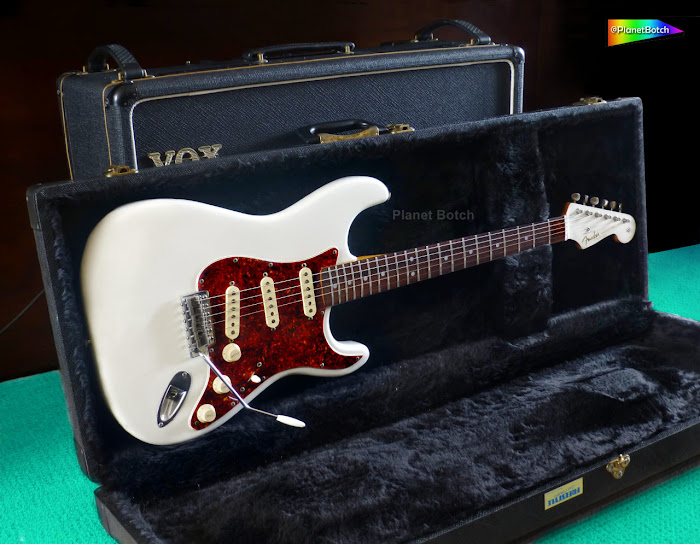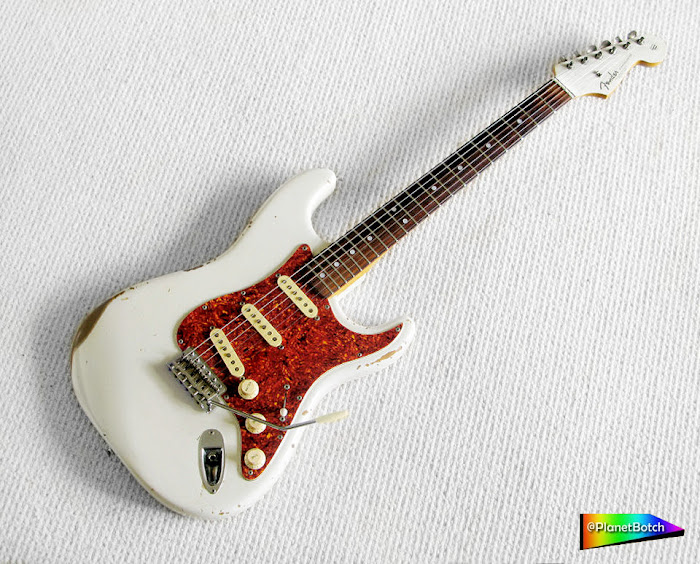In its mid 1980s heyday, The Tokai Goldstar Sound was memorably referenced by Making Music - the UK's biggest musicians' paper - as an arSetractor. Logical enough. I mean, what else do you call a Strat replica when you're not allowed to say Stratocaster? The hotly-sought monthly paper went on to summarise the Goldstar as follows...
"The original... er... Tokai. High quality guitar (almost too good to be called a copy) with authentic sound and excellent finish. Recent rumours of poor quality have been scotched by the latest batches. This is the guitar that made Fender invent the Squier. Play it and see why."
No further questions, m'lud.
I bought my Tokai Goldstar Sound TST-60 model brand new for the grand sum of £195, from Musical Exchanges, Old Snow Hill, Birmingham, England, on Wednesday 22nd August 1984. The shop closed down at the turn of the century, but I still remember that mid 'eighties day. Not least because the original secondhand Selmer hard case was (exaggeration alert) about eight times as heavy as the guitar. But the fact that I chose a Tokai and not one of the very enticing Squier JV Series Strat reissues that Fender had introduced in a bid to destroy it, attested to the slick marketing Tokai enjoyed in the UK.
Tokai offered a much wider range of finishes than Squier, who stuck rigidly to a few vintage-accurate colours. Post-Squier, Tokai were deliberately shipping attention-grabbing aesthetics - including metal-flake bursts and the like - which would bag their Strat replicas primary display positions in the stores. Meanwhile, Tokai's UK distributors produced some of the period's most eyecatching full-page ads for the magazines, and calculatedly tripped round the guitar shops giving away "Tokai is Rock 'n' Roll" T-shirts to the staff. To the teenager that I was at the time, the hype proved irresistible. If the guys in the guitar shop wore Tokai T-shirts, Tokais must be brilliant, right?...
The guitar I bought that summer is still with me today, and whilst it's nothing like my oldest guitar, it's my oldest surviving owned-from-new guitar. It also has the greatest sentimental value of all my guitars, based on its gigging history and association with various nostalgic projects and moments in time.
For anyone interested in the historical side of the Goldstar Sound and its commercial ups and downs during the '80s, there's more in my TST-50 article.
But to return to what's essentially a condensed life story, the TST-60 covered in this piece was originally finished in Lake Placid Blue with a matching blue headstock and a white 3-ply scratchplate.
The "60" in the TST-60 model code related to the guitar's Japanese domestic price bracket in thousands of Yen - not to the decade of the replica's feature set. On the UK market there were TST-40s and TST-50s available at lower prices. And the price range went upward too - although TST-70s were not commonly stocked, since most buyers would not appreciate their greater dedication to vintage accuracy and would not pay their higher RRPs. The TST-50s sold in the highest volume. And it was possible for stores with large warehouse stocks to confuse the variants, selling higher grade models too cheaply by mistake. Perhaps another reason why TST-70s were far less commonly seen.
In each price band, the Goldstars came in a choice of late '50s or mid '60s replicas. My TST-60 is modelled on a 1964 Fender Stratocaster. The year replicated was evident from appointments such as the pearloid fingerboard dot markers with 'narrow' spacing at the twelfth fret, the small, pre-1966 headstock, plus more obsessive details like the light grey fibre pickup construction, and even a period-accurate Fender 'L' series serial number!
Despite the importance it's come to have in my life, I wasn’t immediately thrilled by the TST-60 in use. New Strats tend to sound pretty thin and clinical, and compared with a Squier JV Series Telecaster ('52 reissue) I’d been using since ’83, the TST-60 was initially a bit polite and nondescript. In fact, I used to lend the Tokai Goldstar to the other guitarist in the band I was in at the time, and he used it in preference to his single pickup Westone Paduak. However, in Feb ’85 after that band had split, I used the Tokai on a studio demo with a Melos tape echo unit adding slapback delay, and the character of the guitar finally struck me.
From that point forward, the Tokai became my main guitar, and I used it live and in the studio with three mid 'eighties bands, one of which remains a favourite. Around spring 1985 I fitted a 3-ply black scratchplate and a Federico copy of a DiMarzio SDS-1 pickup in the bridge position. The idea was to produce thicker overdrive using the Federico's much higher gain.
The pickup did have the gain, but it didn't sound anywhere near as good as the Tokai bridge pickup. And unfortunately there was no switching back, since ham-fisted, teenage Bob had managed to damage the original pickup during removal. The Federico ended up in the neck position, with the Tokai's original neck pickup moving to the bridge. Despite the fact I didn't like having the Federico in the neck position any more than at the bridge, the TST-60 did get a lot of use in this guise.
In 1986, desperate to buy a Yamaha DX7 synthesizer, I sold practically every excess piece of gear I could get my hands on – including the TST-60. Luckily, I sold the Tokai to someone I knew. So a couple of years later after I’d realised what an idiot I’d been, I sold the DX7, bought a Rickenbacker 330 with some of the proceeds, and was able to arrange a deal which would also get me back my Tokai.
MORE MODIFICATIONS
When I re-acquired the TST-60 in 1988, still with black scratchplate and that grim Federico at the neck, the original finish was looking pretty disturbed. The blue paintwork had been extremely thin from the start, and the wood beneath it was winning the battle for attention. Also, due to a fairly rapid fading of the body finish, the originally matching blue headstock no longer matched.
Although the guitar could have done with an immediate cosmetic makeover, the first priority was to get rid of that Federico pickup. Someone at the guitar shop recommended a Seymour Duncan Alnico II Pro as the best replacement for the original Tokai unit, and whilst it didn't sound the same, I was blown away by the warm but still well-defined and Stratty tone. The Alnico II went into the bridge position, and I replaced the black scratchplate with a 'mint green' in real celluloid around the same time. I subsequently bought two more Duncan Alnico IIs when I could afford them.
After these mods the Tokai's sonic output easily subordinated that of a Squier System I Strat I'd bought in late '87. But the still-increasing colour discrepancy between the Tokai's body and headstock grated more and more as the '80s became the '90s.
Even between 1984 and 1988 the guitar's tone had matured, and with regular playing the output continued to darken further. In fact, by the instrument's tenth birthday in 1994, the natural tone had mellowed down so much that the alnico II pickups no longer sounded quite bright enough. It made sense at that point to switch the pickups for brighter alnico Vs, and I'd actually got a spare set of Fender Custom Shop Texas Specials, which I'd tried in a new Strat and found too harsh.
The Texas Specials were the perfect match for the Tokai's mellower natural tone and rounder bass end, and I was very conscious of the fact that in another decade or so I might end up with a guitar that fell into the tonal ballpark of Stevie-Ray Vaughan's Number 1. Wow. Just imagine...
Immersed in the quest to turn this trusty partner into an ultimate epic tone machine, I resolved to replace its now rather disgusting poly finish with real nitro-cellulose - attempting to maximise the potential for the wood to mature, as well as complete a visual makeover. I’d already refinished a few guitars and had reached the point where I could make a decent job of it.
To go with the classic Olympic White finish I'd chosen, I bought a real celluloid shell guard from Fender's Custom Shop collection. A new chapter was about to begin...
GOLDSTAR REBORN
Pristine in its new white livery, by the mid '90s the TST-60 was finally free of a compromised aesthetic that had been a bugbear since 1988. But the intention was not to keep the guitar pristine. The intention was to treat it exactly like Stevie-Ray had treated his Strats. I was (and still am) convinced that intensive use had been one of the reasons the tone had improved so markedly to date. So, off went the arSetractor, back into the pubs and bars - acquiring itself more local history, memories and nostalgia as it lived out the life it was built to live.
Since its retirement from live performance (and mine) in 2008, the TST-60 has settled into an era of stability and predictability. It does still see a lot of use, but its sonic persona doesn't really develop much anymore. As I update this post in August 2022 the guitar has reached the ripe old age of 38 years, and there must surely be a limit to the amount that a piece of wood can evolve.
I'd have loved to add the perfect fairytale ending to this guitar-life-story post, but despite all the effort, my 1984 Tokai still doesn't sound like Stevie's Number 1 did in the '80s. With that said, Stevie's other Strats didn't sound like Number 1, so why should my random 1984 job which isn't even a real Fender end up sounding like it?
There is, however, something deeply spiritual about sharing so much of your life and so many memories with a guitar. Knowing the exact day the instrument left the shop, which shop it left, and that you were its first owner. Remembering when it got you to the last 16 of Guitarist magazine's Guitarist of the Year contest. When it made reviewers rave. When it joined forces with a battery-powered Vox Busker amp and drew an impromptu crowd on the streets of 1980s Birmingham. Remembering all the long-closed and/or demolished pubs and bars where it barked out its gutsy roar. The rocking crowds. The bouncing PA engineers. The barmaid who literally leapt up and down while serving drinks as the Japanese-made six-string blasted out an entirely solo rendition of Live Wire...
I reckon that was £195 pretty well spent.




